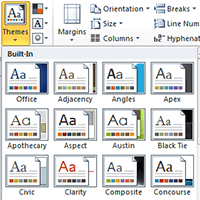


Chicago style prefers the em dash with no space between words. To insert an em dash (-) press the Ctrl, Alt, and the minus key simultaneously. To insert an en dash (–) press the Ctrl key and the minus key simultaneously. To insert a hyphen (-) use the hyphen key or the minus key. Many authors simply type two hyphens, which Word automatically converts to an en dash (most times) when typing continues. The em dash, often simply called the dash, is the most commonly used. Dashes can be used instead of commas, parentheses, or colons, and to show interrupted dialogue. One of the more common mechanical problems authors seem to have is with the dash. Published page numbers will, of course, be different. Having a page reference is helpful when editors and authors correspond. Start the header (or footer) on page two. This is the traditional order for the more common divisions of a book: Front Matter: Title page, Copyright page, Dedication, Epigraph, Table of Contents, Foreword, Preface, Acknowledgments, Introduction (if not part of text), First text page (Introduction or Chapter 1) Back Matter: Acknowledgments (if not in front matter), Appendix, Notes, Glossary, Bibliography or References, Index.Ī useful option is to provide on your manuscript’s cover page your contact information and a word count, like this:Īnother useful touch is to add a header with your surname, the book’s title, and page numbers. All content to be included in the finished book, such as Dedication, Acknowledgments, Foreword, Preface, Appendix, and Index, should be included in one file. Manuscripts should be one contiguous file for all text. If you use British, Canadian, or Australian spelling, make a note to the editor to keep it British or to Americanize it. An alternative style is to insert a blank line, but a reader can miss this extra line if it falls at the bottom of a page. If you want to show that a scene changes within a chapter, use a row of three asterisks on an extra line, set on a line by themselves. It’s one of the most widely used typefaces. There are other acceptable fonts, but Times New Roman is a standard in book publishing for its legibility and classic look. Font throughout should be Times New Roman, 12 pt. Manuscripts should be set up 8.5″ x 11″ with one-inch margins on all sides. (APA formatting for academic manuscripts is a different animal.) If you need help with the mechanics, I’ll provide that later.
#Using styles in word 2010 how to
Here’s how to format your novel or memoir so it looks professional.

Part of my job as a copy editor is to fix the formatting to publishers’ standards.
#Using styles in word 2010 update
On the Home tab, in the Styles group, right-click the style that you want to change, and then click Update to Match Selection.Authors submit manuscripts in a hodgepodge of formats. When you select text that has a style applied, that style is highlighted in the Styles gallery.įormat the selected text with the new attributes that you want.įor example, you might want to change the point size for the Heading 1 style from 16 points to 14 points.

Select text in your document that has the style applied, such as Heading 1. If you have text in your document that already has a style applied, you can change the formatting of that text and apply it to the style in the Styles gallery. Modify a style manually in the Modify Style dialog box Modify a style by updating it to match formatting in your document You can modify an existing style in the Styles gallery in two ways: To learn more, see Apply a style to text in Word. To apply a style, simply select the text you want to format, and then click the style you want in the Styles gallery. The styles covered in this article are located in the Styles gallery, a visual menu located on the Home tab. You can also select formatted text in your document to create a new style in the Styles gallery. You can change the formatting (such as font size, color, and text indentation) in styles applied to titles, headings, paragraphs, lists, and so on. If you want formatting choices that are not available from the built-in styles and themes available in Word, you can modify an existing style and customize it to suit your needs. You can use styles to quickly apply a set of formatting choices consistently throughout your document.


 0 kommentar(er)
0 kommentar(er)
